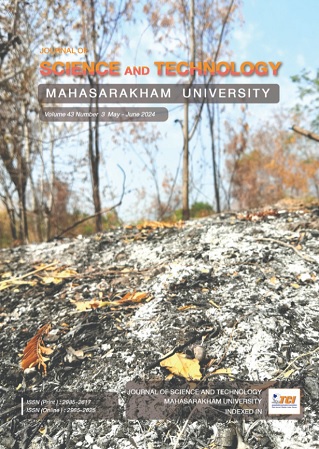Investigation of the impact of five adhesives on the absorption, diffusion rate, and evaporation in fabric attached to aluminum plate
Main Article Content
Abstract
The objective of this experimental study was to identify a suitable type of adhesive that can effectively enhance the absorbency rate and water evaporation capacity of fabrics, consequently improving the cooling capacity of evaporative coolers. Five distinct adhesives, utilized as binders between fabric and aluminum, were compared. The water absorption and diffusion rate through the adhered fabric onto the aluminum workpiece was evaluated by observing the behavior of water droplets. The evaporation capacity was measured in a test rig by assessing the outlet humidity ratio of air after flowing over the wetted sample. Among the tested adhesives, Draga glue demonstrated superior performance in terms of water diffusion rate, evaporation, and cost per unit mass. With Draga glue, water diffusion rates were 5.64, 7.36, and 11.52 times higher than those of SikaFlex 740, hot glue, and SA, respectively. The outlet humidity ratio from the Draga glue sample reached 16.91 g/kg, exceeding the rates of SikaFlex 740, hot glue, and SA by 22.17%, 22.46%, and 26.70%, respectively. Economically, Draga glue was found to be twice as cost-effective per unit mass as the other adhesives studied. These findings indicate that the use of Draga glue can significantly enhance the diffusion rate, evaporation, and cooling capacities of evaporative coolers.
Article Details
References
ก้องนที วัฒนานุสิทธิ์ และ อาทิตย์ คูณศรีสุข. (2566). การศึกษาเชิงทดลองของระบบทำความเย็นแบบน้ำระเหยโดยอ้อมชนิดอากาศไหลย้อนกลับ, การถ่ายเทพลังงานความร้อนและมวลในอุปกรณ์ด้านความร้อนและกระบวนการ ครั้งที่ 22. คณะวิศวกรรมศาสตร์ มหาวิทยาลัยเชียงใหม่.
AATCC 79. (2014). Absorbancy of textiles, AATCC technical manual. AATCC, Research Triangle Park.
ASHRAE. (2013). American society of heating refrigeration and air-conditioning Engineers, Inc. 1791Tullie Circle N.E.
Aumpai, N., & Koonsrisuk, A. (2020). An experimental investigation of an integrated system of split air conditioner and indirect evaporative cooler. Proceedings of the 19th conference on Energy, Heat and Mass Transfer in Thermal Equipment and Processes. Chanthaburi, Thailand.
Delfani, S., Esmaeelian, J., Pasdarshahri, H., & Karami, M. (2010). Energy saving potential of an indirect evaporative cooler as a pre- cooling unit for mechanical cooling systems in Iran. Energy and Buildings, 42(11), 2169-2176. doi.org/10.1016/j.enbuild.2010.07.009
Lertsatitthanakorn, C., Rerngwongwitaya, S., & Soponronnarit, S. (2006). Field experiments and economic evaluation of an evaporative cooling system in a silkworm rearing house. Biosystems Engineering, 93(2), 213-219.doi.org/10.1016/j.biosystemseng.2005.12.003
Li, A., Thu, K., Ismail, A. B., Shahzad, M. W., & Ng, K. C. (2016). Performance of adsorbent- embedded heat exchangers using binder- coating method. International journal of heat and mass transfer, 92, 149-157.doi.org/10.1016/j.ijheatmasstransfer.2015.08.097
Sengupta, S., Ghosh, P., & Mustafa, I. (2022). Properties of poly-vinyl alcohol bonded jute (corchorus olitorius) nonwoven fabric and its performance as disposable carry bag. Journal of Natural Fibers, 19(6), 2034-2052.doi.org/10.1080/15440478.2020.1798842
Xu, P., Ma, X., Zhao, X., & Fancey, K. S. (2016). Experimental investigation on performance of fabrics for indirect evaporative cooling applications. Building and Environment, 110, 104-114.doi.org/10.1016/j.buildenv.2016.10.003
Xu, P., Ma, X., Zhao, X., & Fancey, K. (2017). Experimental investigation of a super performance dew point air cooler. Applied Energy, 203, 761-777. doi.org/10.1016/j.apenergy.2017.06.095


